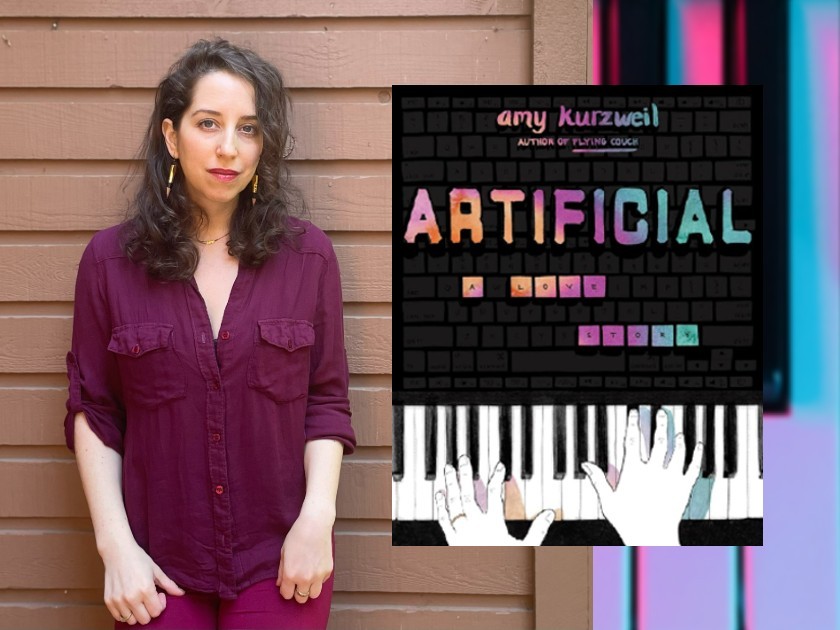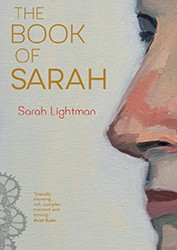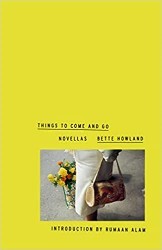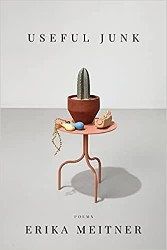
Author photo by Amy Kurzweil
Megan Reynolds speaks with Amy Kurzweil on graphic memoir Artificial: A Love Story, discussing family, felines, and documentation.
Megan Reynolds: Amy, this is another impressive graphic memoir and what a treat to see your relationship with your father and Jacob after Flying Couch followed the intergenerational intricacies of your maternal grandmother and mother. Why did you want to focus on the paternal side of your family for this graphic memoir?
Amy Kurzweil: A writing teacher in college once told me something like, each writer has two stories to tell: one about their mother and one about their father. And apparently I’d be telling some version of these two stories for the rest of my writing life. (So far, so true.) With Flying Couch, people often asked me about the relative absence of men in the book, and I responded by noting that Flying Couch is a memoir about mother-daughter relationships, home and domestic spaces (historically the domain of women), and that my grandmother’s losses in the Holocaust were predominantly female family members. Men felt peripheral to the fraught familial bonds of women in this context.
So when some readers asked: where is your father, the futurist and inventor Ray Kurzweil, in your debut memoir? I could only respond: don’t worry, he’s next.
I think readers were curious about my father’s absence because he is an especially compelling person. He’s a public person, already the subject of films and other books, a writer of his own books, and a name associated with dramatic ideas about the future of humanity. A question I grew up hearing often was: what’s it like to be the daughter of Ray Kurzweil? Are there half-built robots hiding under your bed and flying-machines idling in your garage? This question tickled me philosophically because I couldn’t know what it was like to be the daughter of anyone else — or could I? Can we know what it’s like to be anything other than ourselves? These kinds of questions were starting to appeal to me in my twenties, and it’s lucky that I happened upon a philosopher (enter my partner, Jacob) to help me engage with them.
My home wasn’t full of half-built machines growing up, but it was full of ideas. While my father is known for thinking about the future, I’ve always known him as someone who is steeped in the past. I learned about my father’s storage unit, full of the archives of my grandfather Fred, a musician who dramatically escaped the Nazis because of his musical talents. My father believed he could “resurrect” his father through technology, and he was starting to act upon this belief by building a chatbot from Fred’s writing! This was not a project a philosophically-minded memoirist like me could turn away from, especially as my own life (all of our lives) was increasingly mediated by the digital world. I also saw this as an opportunity to try to get to know the one grandparent I never got to meet.
MR: So much of this book is focused on how to love someone in the face of loss. How do you
think your family’s connection to the Holocaust impacts your philosophies on that? You mention in the book that you and your father are both documentors. What do you document? How does memory factor into both your work and your father’s, which, in my mind, both seek to accomplish similar goals: to remember and exist beyond the body?
AK: My family’s history of losing people and homes has inculcated me and my father with a compulsion to save and to document. I document through writing and drawing. In addition to my books, I keep sketchbooks and handwritten journals. For me, drawing preserves and relays emotional experience, and making marks by hand helps solidify living memory (when I write something down by hand, for example, I tend to remember it better). My father documents by saving information. He would never delete an email, for example. The storage unit featured in my book is full not only of Fred’s artifacts, but of father’s archives as well: poems he wrote when he was a child, typewritten letters to his family members when he was in college. He has kept organized journals of his daily life in excel spread sheets ever since I’ve known him.
Something the research for this book taught me that I didn’t fully appreciate before is that documentation, for Jews escaping Europe, was life. So much of the story of my family’s escape from Vienna was the story of standing in lines to show the authorities pieces of paper that documented certain things that needed to be true in order for them to leave Europe and not die. I came to see my father’s commitment to the immortality of information in relation to this history: preserved documents are the basis for future digital life just as documents were my grandfather’s escape from death.
Another inheritance from my grandfather’s escape story, which lives in my father, and, in different ways, in me, is the commitment to ambition and excellence as a way to live and live on. You could trace my father’s ambitions, his commitment to what I refer to in Artificial as Kleos, the Greek concept of living on through notoriety, to my grandfather’s escape story. If he had not attracted the attention of the American benefactor who sponsored him to America after hearing him play a choral concert in Vienna, he might not have lived past twenty-six. Being an excellent musician saved his life.
Love is a negotiation between self and other. For those of us who come from these histories, or histories like it, how do we negotiate our own compulsion for self-preservation with the time and attention it takes to love other people? This is, as I see it, the greatest (and most important) balancing act of adult life.
Something the research for this book taught me that I didn’t fully appreciate before is that documentation, for Jews escaping Europe, was life.
MR: Much of Artificial questions where the soul is in artificial intelligence and robotic
“reanimation.” According to the graphic memoir, the soul seems to lie in art (and especially for Fred, in music). Can you elaborate on this a bit? What is the soul and where do you find it in your own work?
AK: For me, the slippery concept of “soul” lives in the things that are not instrumental. Usually we talk about something having soul when it is an end in itself, like love, or sadness, or artistic expression. These things exist because they are central to human experience. They aren’t serving some purpose. They just are. We experience things as “soulless” when, for example, they serve a bottom line. Instagram feels soulless to the extent that it serves ad-driven revenue streams. (Although there’s still plenty of soul to be found in the very real yearning for attention and connection.) Technology and art are both extensions of human creativity, and both can feel soulless when they lose direct connection to authentic human emotion and yearning.
Soul is also connected to mystery. Because we can’t explain why we love someone, the phenomenon is experienced as automatic and therefore essential. As a highly cerebral person, I find a lot of soul in drawing because it’s connected to those non-explanation-seeking parts of me: my hand, my arm, my breath. I have a past life as a dancer, and dance is probably the place I access the most “soul,” partly because it’s not my career. Increasingly, I enjoy improvisational dance forms and in these realms, expressive movements happen for no particular reason other than feeling right; I end up feeling connected to other bodies in space just because that’s a natural thing to feel. I try to access this intuition in my drawing, because I think it’s the key to the soul.
The extent to which AI “has a soul” is the extent to which it helps human beings access things like wonder and connection to others. AI doesn’t need to become some emergent consciousness (whatever that is — for me, consciousness is a rabbit-hole concept) in order to facilitate soulful experiences for the humans who engage with it. AI, like art, just needs to be a true facilitator for meaningful human values and yearnings.
MR: Can you explain how you think illustrating this story impacts how you tell it (and how we read it) rather than a traditional prose narrative? You sneak in so many visual elements (I was cracking up at including SoulCycle when you’re discussing The Symposium). What were some of your favorite spreads to work on and which ones gave you some trouble?
AK: It’s fun that you asked me a question about visuals and then the SoulCycle detail you mentioned is actually made of words. I love that you did that, because something I love about comics is the way it blurs the line between text and image. This blurriness has interesting implications for how we think about the chatbot of my grandfather; it speaks to a limitation of digital-text-based language as the only tool for preserving information. In this book, the visual element is so key because the reader gets to experience my grandfather’s documents as I first experienced them, as paper in my hands. There’s also something meaningful about the process of drawing not only images but words. Drawing — especially drawing analog by hand, as I did for everything in this book — slows you down, it requires a lot of time and attention. I spent a lot of time tracing and penciling and inking and watercoloring reproductions of my grandfather’s life: his words, his handwriting, his face and body. This time and attention was an essential element for the mission of the book: to get to know him, and to get to love him.
MR: I’d love to talk about the cats in Artificial. You have them running around throughout the book but don’t reveal why until later on when you detail an impactful brush with death — your college cat. Why did you feel it important to make them a running (literally and metaphorically) visual theme? And, do you still have the robocat?
AK: Why yes I still have my Joy For All robot cat, Samantha 2. She’s been through three moves, so she’s a little tattered, but I just replaced her batteries and she’s doing great. I associate cats with my father because he has, for my whole life, boasted an epic collection of cat figurines. I see a particularly poetic instantiation of the artificial standing in for the real in the fact that my father loves cats, but he’s allergic to cats. Once my childhood cats died, he noticed how much better he could breathe, and so I had to make do with the figurines. Many of these figurines are drawn directly into my book, and they are printed on the book’s endpapers. (This is my favorite element of the book. If anything should persuade you to own a physical copy of Artificial, let it be those cat endpapers!)
Animals are often our first experience with death. For me, first it was my hamsters (chronicled in chapter one of Flying Couch), later my childhood cats (I still have dreams where Fluffy is alive) and then my adulthood cat died suddenly and tragically, in a way that manifested some of my deepest fears about the people (and animals) I love. For all these reasons, I associate cats both with mortality and with immortality through artifice. And they are absolutely the most wonderful thing in the world to draw.
MR: Are you working on any new projects right now? What’s the next great Kurzweil masterpiece you have planned?
AK: I admit that after a project this dense, I’m in need of a good long rest, which is hard for someone like me to take. But I’m trying! Unfortunately for my dreams of rest, there are three projects I’d like to work on next. One is a more journalistic essay collection about technologies of connection and communication (a continuation of the four Technofeelia comics I’ve published with The Believer Magazine). Two is a collection of short stories about care and caretakers (informed by research I’ve been doing on feminist care ethics). Lastly, I’d like to compile the lessons from my graphic narrative classes into a craft book on comics and memory. But first I think I better go take some more dance classes!
Dr. Megan Reynolds is the Development Manager for the National Book Foundation. Before joining the National Book Foundation, Megan Reynolds served as the Development Coordinator at Jewish Book Council. Megan holds a Ph.D. in English from the University of Oregon and BA in English with minors in Creative Writing and Spanish from Trinity University. She is originally from New Mexico and now lives in New York City.


